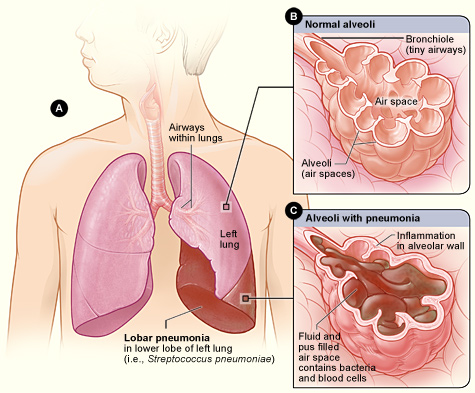Difference Between Hypothermia and Pneumonia
Table of Contents
Key Differences – Hypothermia vs Pneumonia
Hypothermia and pneumonia by definition are two completely different clinical conditions. Hypothermia is the falling of body temperature below 35ºC as a result of the inability of body’s thermoregulatory mechanisms to maintain the core temperature at a constant level. Invasion of the lung parenchyma by a disease-causing agent (mostly bacteria) evokes exudative solidification (consolidation) of the pulmonary tissue known as pneumonia. Pneumonia is an infectious pathological condition while hypothermia is a physiological derangement with fatal consequences. This is the key difference between hypothermia and pneumonia.
CONTENTS
1. Overview and Key Difference
2. What is Hypothermia
3. What is Pneumonia
5. Side by Side Comparison – Hypothermia vs Pneumonia in Tabular Form
6. Summary
What is Hypothermia?
Hypothermia is the falling of body temperature below 35ºC as a result of the inability of body’s thermoregulatory mechanisms to maintain the core temperature at a constant level.
Infants and elderly people are the two most susceptible age groups to get hypothermia. In infants, this can be attributed to the poorly developed thermoregulatory mechanisms and high surface area: weight ratio.
Secondary Causes of Hypothermia
Even healthy individuals can become hypothermic when the thermal stress overcomes the thermoregulatory mechanisms functioning at their peak.

Clinical Features
Mild Hypothermia
- Cold and shivering
- Confusion
- Dehydration
- Ataxia
Severe Hypothermia
Investigations
- Blood gases- arterial decreases by 7 % per every drop in the core temperature
- Full blood count
- Electrolytes
- Chest X ray
- ECG – J waves which appear at the junction between ST segment and QRS complex. The patient can have ventricular fibrillation and cardiac dysrhythmias.
- Additional investigation to find out any thyroid dysfunctions, pituitary abnormalities and hypoglycemia should be performed.
Management
The management of hypothermia aims at,
- Resuscitation
- Rewarming the patient in a controlled manner
- Treatment of associated hypoxia
- Correction of the electrolyte imbalance
- Treatment of cardiovascular abnormalities – special care should be taken to prevent the occurrence of dysrhythmias
What is Pneumonia?
Invasion of the lung parenchyma by a disease-causing agent (mostly bacteria) evokes exudative solidification of the (consolidation) of the pulmonary tissue known as pneumonia.
Classification of pneumonia is based on several criteria.
- Bacterial, viral, fungal
- Lobar Pneumonia, Bronchopneumonia
- Community acquired, hospital acquired
- Suppurative, fibrinous
Pathogenesis
The normal lung is devoid of any disease-causing organisms or substances. The respiratory tract has several defence mechanisms aimed at preventing the entry of these disease-causing agents.
- Nasal clearance – particles deposited in the front of the airway on the non-ciliated epithelium are normally removed by sneezing or coughing. The particles deposited posteriorly are swept over and will be swallowed.
- Tracheobronchial clearance – this is accompanied by mucociliary action
- Alveolar clearance – phagocytosis by alveolar macrophages.
Pneumonia can be contracted whenever these defences are impaired or the host resistance is decreased. Factors such as chronic diseases, immunosuppression and use of immunosuppressive drugs, leukopenia, and viral infections affect the host resistance, making the host vulnerable to get this kind of disorders.
The clearance mechanisms can be damaged in several ways,
- Suppression of the cough reflex and the sneezing reflex
Secondary to coma, anaesthesia or neuromuscular diseases
- Injury to the mucociliary apparatus
Chronic smoking is the major reason for the destruction of the mucociliary apparatus.
- Interference with the phagocytic action
- Pulmonary congestion and edema
- Accumulation of pulmonary secretions in conditions such as cystic fibrosis and bronchial obstruction.
Bronchopneumonia
- Staphylococci, Streptococci, Pneumococci, Haemophilus, and Pseudomonas auregenosa are the main causative agents.
Morphology
- Foci of bronchopneumonia are consolidated areas of acute suppurative inflammation. The consolidation may be patchy through one lobe but is more often multilobar and frequently bilateral.
Lobar Pneumonia
- Main causative agents are pneumococci, klebsiella, staphylococci, streptococci

Figure 02: Lobar Pneumonia
Morphology
Four stages of inflammatory response have classically been described.
- Congestion
The lung is heavy, boggy, and red.This stage is characterized by vascular engorgement, intra -alveolar fluid with few neutrophils, and often the presence of numerous bacteria.
- Red Hepatization
Congestion is followed by red hepatization, which is characterized by massive confluent exudation with red cells, neutrophils, and fibrin filling the alveolar spaces.
- Grey Hepatization
In the grey hepatization stage, because of the progressive disintegration of the red blood cells that have accumulated in the alveolar spaces, lungs assume a grey colour. This greyish appearance is enhanced by the presence of the fibrino suppurative exudate.
- Resolution
During the final stage of the pathogenesis, the consolidated exudate that has accumulated within the alveolar spaces undergoes progressive enzymatic digestion to produce a granular semi -fluid debris that is reabsorbed and ingested by macrophages or coughed up.
Complications
- Abscess – because of the tissue destruction and necrosis
- Empyema – as a result of the infection spreading into the pleural cavity
Clinical Features
What is the Difference Between Hypothermia and Pneumonia?
Hypothermia vs Pneumonia | |
| Hypothermia is a drop in the core temperature below 35ºC as a result of the failure of body’s thermoregulatory mechanisms to maintain body temperature within the appropriate range. | Invasion of the lung parenchyma by a disease-causing agent (mostly bacteria) evokes exudative solidification of the (consolidation) of the pulmonary tissue known as pneumonia. |
| Charge | |
| This is an infectious pathological condition. | This is more likely to be a physiological derangement. |
Summary – Hypothermia vs Pneumonia
Pneumonia is an infectious pathological condition characterized by the inflammation of the pulmonary parenchyma. But hypothermia is a drop in the core temperature below 35ºC as a result of the failure of body’s thermoregulatory mechanisms to maintain body temperature within the appropriate range. This is the key difference hypothermia and pneumonia.
Download PDF Version of Hypothermia vs Pneumonia
You can download PDF version of this article and use it for offline purposes as per citation notes. Please download PDF version here Difference Between Hypothermia and Pneumonia
References:
1. Colledge, Nicki R, Brian R. Walker, Stuart Ralston, and Stanley Davidson. Davidson’s Principles and Practice of Medicine. Edinburgh: Churchill Livingstone/Elsevier, 2010. Print.
Image Courtesy:
1. “Lobar pneumonia illustrated” By Heart, Lung and Blood Institute – (Public Domain) via Commons Wikimedia
2. “SERE exercise” by UNC – CFC – USFK (CC BY 2.0) via Flickr
ncG1vNJzZmivp6x7pbXFn5yrnZ6YsqOx07CcnqZemLyue8OinZ%2Bdopq7pLGMm5ytr5Wau2602KmmraCVp7qqrYyapZ1lpqh6sbrErqSoppmWfA%3D%3D